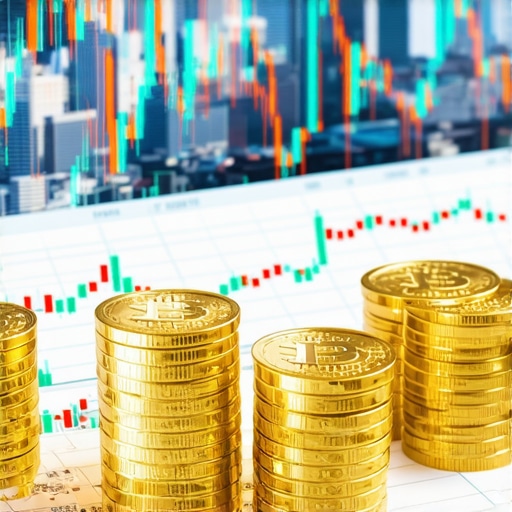Introduction to Gold Market Dynamics
The gold market is a complex landscape, shaped by various economic factors, investor behavior, and global events. Understanding these dynamics is crucial for anyone looking to invest in gold, whether through physical assets, gold ETFs, or mining stocks. This article will delve into the essential elements that influence gold prices and market trends, providing you with the knowledge needed for smart investing.
Key Factors Influencing Gold Prices
Several factors play a significant role in determining gold prices. Supply and demand are fundamental concepts, where an increase in demand often drives prices up, while greater supply can lead to price declines. Recently, the global demand for gold has been bolstered by a surge in physical gold purchases, particularly in countries like China and India. This demand stems from cultural practices, as well as investment strategies aimed at hedging against inflation.
Another crucial aspect is macroeconomic indicators. Economic stability, interest rates, and inflation rates directly impact the attractiveness of gold as a safe-haven asset. In times of economic uncertainty, investors flock to gold, viewing it as a stable investment. For instance, during the COVID-19 pandemic, gold prices surged as investors sought refuge from market volatility.
The Role of Central Banks
Central banks also significantly influence the gold market. Their policies on gold reserves can affect global supply and demand dynamics. When central banks decide to purchase gold, it can lead to increased prices due to heightened demand. Conversely, if they sell off gold reserves, it may result in a drop in prices. Understanding these central bank activities is crucial for investors looking to navigate the gold market effectively.
Investor Behavior and Market Sentiment
Investor sentiment and behavior are essential in shaping the gold market. Market psychology often drives short-term price movements, which can be influenced by news events or global crises. For example, geopolitical tensions can prompt investors to buy gold as a safe haven, driving prices higher. Conversely, if the market sentiment shifts towards riskier assets, gold may see a decline in demand.
Additionally, technological advancements in trading platforms and investment vehicles have made it easier for retail investors to participate in the gold market. This democratization of investing has led to increased market activity and volatility, impacting price movements. Understanding how to analyze these trends is vital for making informed investment decisions.
Conclusion
In conclusion, grasping the intricacies of the gold market dynamics is essential for smart investing. By keeping an eye on key factors such as supply and demand, macroeconomic indicators, central bank activities, and investor behavior, you can position yourself to make informed investment choices. As you navigate this complex landscape, consider exploring further resources to deepen your understanding, such as analyzing gold price trends and understanding gold futures for a comprehensive investment strategy.
Understanding Gold Investment Vehicles
When considering gold investments, it’s essential to explore the various investment vehicles available. Investors can choose between physical gold, such as bars and coins, or financial products like gold ETFs and mutual funds. Each option has its advantages and risks, depending on the investor’s objectives and market conditions.
Physical Gold vs. Gold ETFs
Investing in physical gold offers the tangible benefit of owning a hard asset, which can be particularly appealing during times of economic instability. However, it also comes with storage and insurance costs. In contrast, gold ETFs provide a more liquid investment, allowing for easier buying and selling without the need for physical storage. Understanding the differences between these options helps investors align their strategies with their financial goals.
Evaluating Gold Market Trends
To effectively navigate the gold market, investors must stay informed about current market trends and price movements. This involves monitoring key indicators such as geopolitical events, economic data releases, and changes in central bank policies. By analyzing these factors, investors can identify potential opportunities and risks in the gold market.
Global Events Impacting Gold Prices
Global events, such as political instability, natural disasters, or significant economic shifts, often lead to fluctuations in gold prices. For instance, during times of crisis, investors typically flock to gold, driving prices upward. Understanding how to evaluate these global supply and demand dynamics is crucial for making informed investment decisions.
Investment Strategies for Gold
Successful gold investing requires a well-thought-out strategy. Investors should consider diversifying their portfolios by including gold alongside other assets, such as stocks and bonds. This diversification can help mitigate risk and enhance overall portfolio performance.
Long-Term vs. Short-Term Investing
Investors must also decide on their time horizon. Long-term investors may focus on accumulating gold as a hedge against inflation and currency devaluation, while short-term traders might capitalize on market volatility to achieve quick profits. Each approach comes with its own set of considerations and potential rewards.
The Future of Gold Investments
Looking ahead, the future of gold investments is influenced by various factors, including technological advancements in trading and the evolving landscape of global finance. As more investors turn to digital platforms, there will likely be increased access to gold-related investment products. Staying informed about these trends will help investors adapt and capitalize on new opportunities in the gold market.
In conclusion, understanding the intricacies of gold investment vehicles, market trends, and effective strategies is essential for any investor looking to navigate this dynamic market. By doing so, you can position yourself to make informed investment choices that align with your financial goals. To further enhance your knowledge, consider exploring resources on adding gold to your investment portfolio and top gold investment strategies for maximizing returns.
Understanding Gold Investment Strategies
When it comes to investing in gold, having a clear strategy can significantly enhance your chances of success. As an investor, it’s crucial to recognize that gold can serve multiple roles within a portfolio, whether as a hedge against inflation or a means of capitalizing on market fluctuations.
Integrating Gold into Your Investment Portfolio
Integrating gold into your investment portfolio can provide a layer of security. Investors often add gold to diversify their assets, mitigating risks associated with stock market volatility. As you consider adding gold to your investment portfolio, think about how it complements your existing assets and aligns with your long-term financial goals.
Analyzing Gold Price Trends for Better Decisions
Understanding how to analyze gold price trends is essential for making informed investment decisions. By keeping an eye on market indicators and historical data, you can better predict future movements. Resources like analyzing gold price trends can provide valuable insights into potential price fluctuations.
The Impact of Economic Indicators on Gold Prices
Several economic indicators can influence gold prices, including interest rates, inflation rates, and the strength of the U.S. dollar. For instance, when inflation rises, gold often becomes more attractive as a store of value. Monitoring these indicators can help investors time their entry and exit points effectively.
Gold Trading Techniques for Maximizing Profits
Implementing effective gold trading techniques can lead to substantial profits. Whether you are interested in gold trading techniques or strategies specific to physical gold, having a well-defined approach is critical.
Short-Term vs. Long-Term Gold Trading
Deciding between short-term and long-term trading strategies can shape your investment experience. Short-term traders typically capitalize on market volatility, aiming for quick returns. In contrast, long-term investors might focus on accumulating gold over time, benefiting from its potential appreciation in value. Each approach has its own risks and rewards, so understanding your investment style is essential.
The Role of Central Banks in Gold Markets
Central banks play a pivotal role in gold markets, often influencing prices through their buying and selling activities. Monitoring central bank actions can provide insights into broader market trends. For instance, when central banks increase their gold reserves, it often signals a commitment to the asset’s long-term value, impacting market perception.
Global Demand Trends and Their Influence
Global demand trends also significantly affect gold prices. Countries like India and China are major consumers of gold, with cultural factors influencing their demand. Understanding these dynamics can help investors anticipate shifts in the market. For resources on the current landscape of global demand, consider exploring gold demand trends to stay informed.
The Future Landscape of Gold Investments
Looking ahead, the future landscape for gold investments appears promising, with ongoing technological advancements and changes in investor behavior reshaping the market. Investors who adapt to these changes and utilize innovative investment vehicles will likely reap the benefits.
In conclusion, navigating the intricacies of gold investment requires a deep understanding of various strategies, market influences, and global trends. By integrating gold thoughtfully into your investment portfolio and staying informed about the market, you can position yourself for success in this dynamic environment. To further enhance your investment knowledge, consider exploring top gold investment strategies and how to effectively manage your gold assets for optimal returns.
Key Trends Shaping the Gold Investment Market
The gold investment landscape is continuously evolving, influenced by various factors including economic conditions, market sentiment, and technological advancements. As investors seek to navigate this dynamic environment, understanding the trends that shape gold investments is essential for making informed decisions.
The Rise of Digital Gold Investments
Digital gold investments are gaining traction, enabling investors to buy and sell gold online with ease. Platforms that facilitate these transactions are becoming increasingly popular, appealing to a younger demographic interested in gold as a digital asset. This shift towards digital solutions creates opportunities for investors to engage with gold in innovative ways. For insights on how to approach digital gold investments, explore physical gold vs. digital gold and assess which option suits your investment goals.
Market Sentiment and its Impact on Gold Prices
Market sentiment plays a crucial role in driving gold prices up or down. Investors tend to flock to gold during times of uncertainty, such as geopolitical tensions or economic downturns. Understanding the psychological factors that influence market sentiment can provide valuable insights for timing your investments. By staying informed about current events and analyzing their potential impact on gold prices, you can make more strategic investment decisions.
Technological Advances in Gold Trading
Technological advances are revolutionizing how investors trade gold. From algorithmic trading to advanced analytics, these innovations allow for more precise market analysis and execution of trades. Staying updated on the latest trading technologies can enhance your investment strategy and improve your ability to react swiftly to market changes.
The Importance of Diversification in Gold Investments
Diversifying your gold investments is key to managing risk effectively. Whether you choose to invest in physical gold, gold ETFs, or gold mining stocks, having a mix of different gold assets can protect your portfolio against market volatility. For more guidance on diversification, check out gold vs. stocks and evaluate the benefits of maintaining a balanced investment strategy.
Understanding Gold ETFs and Their Benefits
Gold ETFs (Exchange-Traded Funds) have become a popular choice for investors looking to gain exposure to gold without the complexities of physical ownership. These funds offer liquidity and ease of access, making them an attractive option for many. Understanding how to invest in gold ETFs is crucial for maximizing your returns. For a detailed guide, visit how to invest in gold ETFs.
Preparing for Future Gold Price Movements
As you look ahead, being prepared for potential fluctuations in gold prices is vital. Economic forecasts, supply chain disruptions, and changes in demand can all impact gold prices. By keeping an eye on these factors and regularly reviewing your investment strategy, you can position yourself to capitalize on future opportunities. To gain a deeper understanding of how gold prices are influenced by various factors, consider exploring how gold prices react to market changes.
In conclusion, navigating the future of gold investments requires vigilance and adaptability. By staying informed about key trends, technological advancements, and market sentiment, you can make strategic decisions that enhance your investment portfolio. Embrace the evolving landscape of gold investments and leverage the insights gained to achieve your financial goals.
Frequently Asked Questions About Gold Investments
What are the benefits of investing in gold?
Investing in gold offers several benefits, including portfolio diversification, a hedge against inflation, and protection during economic downturns. Gold often retains its value over time, making it a stable investment choice.
How do I start investing in gold?
To start investing in gold, you can choose from various methods such as purchasing physical gold (coins or bars), investing in gold ETFs, or buying shares in gold mining companies. Research each option to determine which aligns best with your investment goals.
Is investing in gold safe?
Gold is generally considered a safe investment, particularly during times of economic uncertainty. However, like all investments, it carries risks. Understanding market dynamics and diversifying your investments can mitigate these risks.
How does gold perform during economic downturns?
Gold typically performs well during economic downturns, as investors flock to it as a safe haven. When confidence in currencies and stocks wanes, demand for physical gold tends to rise, driving up its price.
What are gold ETFs and how do they work?
Gold ETFs (Exchange-Traded Funds) are investment funds that track the price of gold. They allow investors to buy shares representing a fraction of an ounce of gold without needing to hold the physical metal. This offers liquidity and ease of trading.
Can I lose money investing in gold?
Yes, it is possible to lose money when investing in gold. Prices can fluctuate based on market conditions, geopolitical events, and economic changes. It’s essential to stay informed and have a sound investment strategy.
What factors influence gold prices?
Gold prices are influenced by various factors, including inflation rates, currency strength, interest rates, and global economic stability. Additionally, supply and demand dynamics, along with geopolitical events, can significantly impact prices.
Should I invest in gold or stocks?
Deciding between gold and stocks depends on your investment strategy and risk tolerance. Gold can provide stability and act as a hedge against inflation, while stocks offer potential for higher returns. A diversified portfolio may include both assets.
How do I store physical gold safely?
Physical gold should be stored securely to protect it from theft or loss. Options include safe deposit boxes at banks, home safes, or specialized vaults. Ensure your storage solution is insured for added peace of mind.
Authority Resources for Gold Investment Insights
For those looking to deepen their understanding of gold investments, numerous trusted resources are available:
- World Gold Council – A leading authority on gold investment and market insights.
- Investing.com – Provides up-to-date market data and analysis on gold and other commodities.
- Kitco – Offers real-time gold prices, charts, and news related to gold investments.
- Forbes Gold Section – Articles and guides on investing in gold and market trends.
- Bloomberg Commodities – Comprehensive news and analysis on commodities, including gold.
By leveraging these resources, investors can stay informed and make educated decisions regarding their gold investments.
Conclusion
In conclusion, navigating the world of gold investments requires a solid understanding of market trends, investment strategies, and risk management. By exploring the benefits of gold, its role in diversifying your portfolio, and utilizing reliable resources, you can make informed decisions that align with your financial goals. Whether you opt for physical gold, ETFs, or mining stocks, being well-informed will empower you to take advantage of the opportunities that this precious metal offers.











This post offers a very comprehensive overview of what influences gold market dynamics, and I appreciate the emphasis on macroeconomic indicators and central bank activity. Having personally invested in physical gold and ETFs, I’ve seen firsthand how investor sentiment can shift rapidly based on global events. During recent geopolitical tensions, gold prices spiked as many investors sought safe havens, which aligns with the points made here. I’ve often wondered, how do seasoned investors balance the short-term volatility caused by market sentiment with long-term fundamentals like supply-demand or macroeconomic trends? It seems that understanding market psychology is just as crucial as analyzing economic data, especially with technological advancements making it easier for retail investors to participate. Do others here find that staying informed through real-time news and analytics helps in timing their investments more effectively? I’d love to hear different approaches to managing those emotional swings in the gold market and how they incorporate data into their strategy.